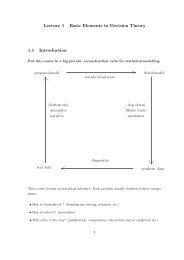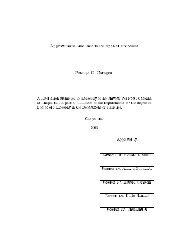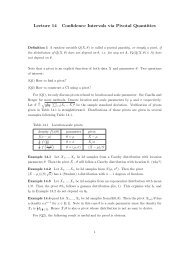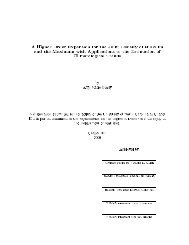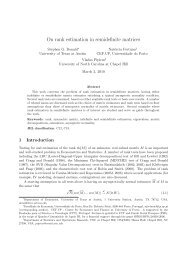Monte Carlo Methods in Statistical Mechanics: Foundations and ...
Monte Carlo Methods in Statistical Mechanics: Foundations and ...
Monte Carlo Methods in Statistical Mechanics: Foundations and ...
Create successful ePaper yourself
Turn your PDF publications into a flip-book with our unique Google optimized e-Paper software.
d = 2 Is<strong>in</strong>g Model<br />
L <strong>in</strong>tE<br />
64 1575 ( 10) 5.25 (0.30)<br />
128 5352 ( 53) 7.05 (0.67)<br />
256 17921 (109) 6.83 (0.40)<br />
512 59504 (632) 7.99 (0.81)<br />
Table 1: Susceptibility <strong>and</strong>autocorrelation time <strong>in</strong>tE (E =energy slowest mode) for<br />
two-dimensional Is<strong>in</strong>g model at criticality, us<strong>in</strong>gSwendsen-Wang algorithm. St<strong>and</strong>ard<br />
error is shown <strong>in</strong> parentheses.<br />
nonzero FKSW-measure is accessible from every other. So the SW algorithm is at<br />
least a correct algorithm for simulat<strong>in</strong>g the FKSWmodel. It is also an algorithm for<br />
simulat<strong>in</strong>gthe Potts <strong>and</strong> r<strong>and</strong>om-cluster models, s<strong>in</strong>ce expectations <strong>in</strong> these two models<br />
are equal to the correspond<strong>in</strong>g expectations <strong>in</strong> the FKSWmodel.<br />
Historical remark. The r<strong>and</strong>om-cluster model was <strong>in</strong>troduced <strong>in</strong> 1969 by Fortu<strong>in</strong><br />
<strong>and</strong> Kasteleyn [58] they derived the identity ZPotts = ZRC, alongwiththe correlationfunction<br />
identity (6.9) <strong>and</strong> some generalizations. These relations were rediscovered<br />
several times dur<strong>in</strong>g the subsequent two decades [59]. Surpris<strong>in</strong>gly, however, no one<br />
seems to have noticed the jo<strong>in</strong>t probability distribution FKSW that underlay all these<br />
identities this was discovered implicitly by Swendsen <strong>and</strong> Wang [27], <strong>and</strong> was made<br />
explicit by Edwards <strong>and</strong> Sokal [60].<br />
It is certa<strong>in</strong>ly plausible that the SW algorithm might have lesscritical slow<strong>in</strong>g-down<br />
than the conventional (s<strong>in</strong>gle-sp<strong>in</strong>-update) algorithms: the reasonisthat a local move<strong>in</strong><br />
one setofvariables can have highly nonlocal e ects <strong>in</strong>the other. For example, sett<strong>in</strong>g<br />
nb =0onas<strong>in</strong>gle bond may disconnect a cluster, caus<strong>in</strong>g abigsubset of the sp<strong>in</strong>s <strong>in</strong><br />
that cluster to be ipped simultaneously. In some sense,therefore, the SW algorithm<br />
is a collective-mode algorithm <strong>in</strong> which the collective modes are chosen by the system<br />
rather than imposed from the outside as<strong>in</strong>multi-grid. (The miracle is that thisisdone<br />
<strong>in</strong> a way that preserves the correct Gibbs measure.)<br />
How well does the SW algorithm perform? In at least some cases,the performance<br />
is noth<strong>in</strong>g short of extraord<strong>in</strong>ary. Table 1 shows some prelim<strong>in</strong>ary data [61]onatwodimensional<br />
Is<strong>in</strong>g model at the bulkcritical temperature. These data are consistent<br />
with the estimate SW L 0:35 [27]. 25 By contrast, the conventional s<strong>in</strong>gle-sp<strong>in</strong>- ip<br />
25 But precisely because rises so slowly with L, good estimates of the dynamic critical exponent<br />
will require the useofextremely large lattices. Even with lattices up to L =512,weareunable to<br />
dist<strong>in</strong>guish conv<strong>in</strong>c<strong>in</strong>gly between z 0:35 <strong>and</strong> z 0. Note Added 1996: For more recent <strong>and</strong><br />
49



